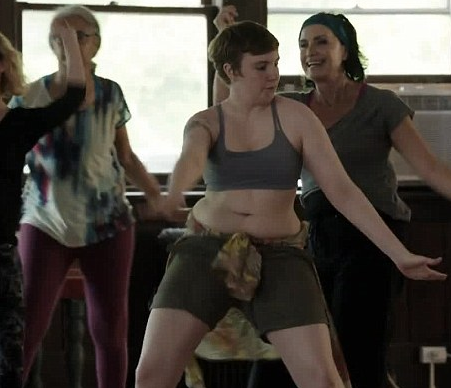The Revolutionary Thighs of Hannah Horvath
Maria San Filippo admires Lena Dunham's radical refusal to be a docile body.
By Maria San FilippoFebruary 21, 2017

“I’M GOING TO SHOW my thighs every day till I die,” vowed Lena Dunham after the social media scorning of her red carpet appearance in short shorts during Girls’s first season. As evidenced by her recent flaunting of cellulite-studded flanks on the cover of Glamour’s February 2017 issue, Dunham maintains that mantra, both as herself (presumably having learned her lesson about airbrushing after unretouched photographs of her 2014 Vogue shoot surfaced) and, going into Girls’s sixth and final season, as alter-ego Hannah Horvath. Although average-sized rather than plus-sized, and joined along the way by other not-thin leading women on screens big and small, Dunham still stands out for her refusal to cover up or slim down.
What so many Dunham haters have dismissed as passive-aggressive exhibitionism remains, to me, a radical refusal of (self-)disciplinary regimes that engender women as what Foucault termed “docile bodies.” Remaining a loyal Girls lover in the face of the nonstop shaming of its white privilege and problematic post-feminism, I’m in no less prickly a position defending Dunham/Hannah’s body-baring — a spectacle that may well elicit a gaze uncomfortably akin to gawking at a freak show attraction. My own response (and I don’t imagine I’m alone) arises from an overidentification that precludes any such othering, and that time and again provokes my admiration at Dunham-as-Hannah’s balancing of defiant self-love and courageous self-mockery. While her “nasty woman” attributes extend beyond body image to encompass a thoroughly unladylike, impressively anti-aspirational protagonist, it is those audacious images — of her splinter-embedded rump, tits-out mesh top, Spring Breakers–worthy string bikini, and love handles aplenty — that remain to me the most indelible across Girls’s run, and as likely to foster a feminist legacy as Laura Petrie’s Capri pants did 50 years ago.
¤
Maria San Filippo is assistant professor of Communication and Media Studies at Goucher College.
LARB Contributor
Maria San Filippo is an associate professor of media studies at Emerson College and editor of New Review of Film and Television Studies. She authored the Lambda Literary Award-winning The B Word: Bisexuality in Contemporary Film and Television (2013) and Provocauteurs and Provocations: Screening Sex in 21st Century Media (2021), both published by Indiana University Press, and edited the collection After ‘Happily Ever After’: Romantic Comedy in the Post-Romantic Age, forthcoming in 2021 from Wayne State University Press. Her website is www.maria.sanfilippo.net and she tweets at @cinemariasf.
LARB Staff Recommendations
400 Blowies: "Girls'" Coming of Age, Finally
This fifth season is a beginning, a coming of age without a clear endpoint or result...as ambivalent and worried as it is triumphant.
That’s So Awkward: Issa Rae and the Revitalization of Black Women in Television
Issa Rae’s fictional characters bring real Black women to TV.
Did you know LARB is a reader-supported nonprofit?
LARB publishes daily without a paywall as part of our mission to make rigorous, incisive, and engaging writing on every aspect of literature, culture, and the arts freely accessible to the public. Help us continue this work with your tax-deductible donation today!